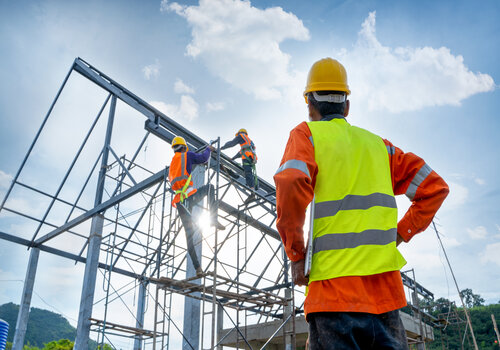Construction is an inherently stressful job for a lot of reasons. Difficult weather conditions, long and irregular hours, tight deadlines, and equipment breakdowns are among some of the biggest stress inducers. On top of that, leaders can sometimes inadvertently create a toxic work culture when even the best intentions are overrun by the pressures to perform.
“The big issue has always been schedule and budget, and the pandemic has made that worse,” says Monica Rakoczy, owner of EnterTRAINING Solutions. “Material delays have become a problem, and inflation is also causing astronomically higher prices. People are left scratching their heads trying to find cost savings somewhere. It’s extraordinarily difficult.”
The issue with workforce is another stress inducer being highlighted right now. “There is a huge shortfall of young people getting into this industry,” Rakoczy says. “At the same time, more Baby Boomers are retiring. So the industry is losing tons of experience and knowledge, and we’re having a hard time replacing it.”
The stress inducers in people’s regular lives have also grown more intense. Concerns about the cost of living and the health of the economy have many worrying about their job and financial security. The typical construction worker can’t help but carry some of this stress with them to the jobsite.
“Many people in the construction industry come from dual-income households,” Rakoczy points out. “In many of those situations, the construction worker in the family is the primary breadwinner. That creates a lot of pressure in and of itself.”
It’s important for construction companies to recognize this reality, and face the fact that stressed-out workers can lead to negative consequences in a lot of ways:
- loss of focus
- increased fatigue
- decreased morale
- reduced safety
- reduced productivity
- increased risk of other health problems, including suicide
Coping with construction site stress as a company requires planning. First, construction companies should take these many factors into account when estimating and coordinating projects, setting goals, and managing workers. The second step, and arguably even more important, is knowing how to recognize and respond to signs of jobsite stress among workers.
Stress management tools and tactics
A 2021 survey study by the Center for Workplace Mental Health sought to gain a better understanding of mental health in the construction industry. The study’s findings and subsequent recommendations can help companies develop a blueprint for supporting workers’ mental health today.
Leaders show commitment. First of all, leaders throughout the company must play a key role in building a culture of caring. It starts with senior management. Top leadership must acknowledge the importance of mental health, and demonstratively support the building of awareness and breaking down of barriers. There has been a longstanding stigma in construction where employees don’t want to ask for help. Senior leadership can set the tone that asking for help is not only OK but encouraged.
Senior leadership should also support its lower-level managers, as that support is sorely needed.
According to the Center for Workplace Mental Health study, 77% of senior leaders have acknowledged mental health as a top priority, compared to just 56% of field leaders. In many regards, field leaders are a lot like the workers they supervise. They are focused on getting the job done, period, no excuses. Senior leaders must convey to these front-line supervisors that coping with stress and mental health is a company priority, while also providing some tools and training to help manage it.
Build awareness. Roughly 94% of the survey respondents said that the sharing of educational resources is a key tactic in coping with stress and mental health among construction workers. Useful resources include:
- Toolbox talks
- Emails about mental health
- Fact sheets
- Posters
- Newsletter content
- Training of both employees and supervisors
- Wallet cards
- Hardhat stickers
Watch for signs. Rakoczy says construction companies can view jobsite stress in the same light as heat stress. The typical construction worker will just try to work through it. To that point, supervisors and workers should help keep a watchful eye on each other. Look for shifts in mood or behavior. Is a normally chipper employee acting a bit snippy from time to time? Is someone constantly looking at their phone when they never did that before? Maybe there’s a good reason why they are looking at their phone, such as monitoring a stressful event in their personal life.
“We as an industry can be a bit more cognizant that there is more to a person than the job they are doing,” Rakoczy says. “Nobody should be afraid to be the first person willing to ask, ‘Is everything OK?’”
Leaders establish a comfort zone. Leaders can further help break down the stigma by being more open about themselves, thereby fostering a more open channel of communication with stressed-out employees.
“Leaders should be willing to talk about what’s going on in their own lives,” Rakoczy says. “Leaders must also be willing to listen. They can’t just ask, ‘Are you OK?’ and then walk away. This is really something that has to be built from the top down. Then every employee can feel comfortable with their own feelings.”
Field supervisors can’t be neglected in all of this. They need support, too. Rakoczy says project managers can visit a jobsite once in a while or even just pick up the phone to touch base with their site supervisors. Those little gestures can help front-line supervisors know that they don’t have to run everything by themselves.
An interesting project underway right now is the Construction Wellbeing Initiative, a collaboration between Princeton University and SkillSignal to focus on the construction industry’s mental health crisis. Among the project’s goals is to analyze field-tested solutions that will increase the physical and mental well-being of construction workers.
According to Rakoczy, solutions don’t have to be complicated to be effective. Coping with jobsite stress could involve simple things like setting up a table and chairs so workers can sit down and eat their lunch, as opposed to sitting alone in their truck or grabbing a bucket to sit on.
“Creating opportunity for camaraderie helps lead to some really valuable human interaction,” Rakoczy says. And it’s the human interaction, built from a foundation of honesty and empathy, that helps break down the barriers to improved mental health on the construction site.
Read Next
Addressing Mental Health in Construction
Construction Is Stressful: Here's How to Manage Stress with Your Crew
Take a STAND: Addressing Suicide Prevention in the Construction Industry












